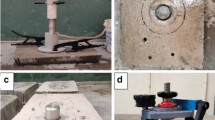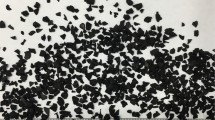Abstract
The reuse of waste rubber in concrete is beneficial for sustainable development of ecological environment. Rubber concrete is often under repeated loading during its service. In this paper, the deterioration characteristics of rubber concrete under equal amplitude high stress repeated loading were analyzed and discussed. Three rubber particle sizes (0.85 mm, 1–3 mm, and 3–6 mm) and a content of 10% of rubber concrete, and ordinary concrete were prepared, which expressed as RC-A, RC-B, RC-C, and OC. The apparent phenomenon, mechanical properties, and stress–strain curve of concrete during repeated loading were tested. The results showed that with the increase in rubber particle size, the peak strain and residual stress increased, and compressive strength and elastic modulus decreased. The damage degree of concrete under repeated loading was calculated by energy dissipation method. Rubber concrete has great damage after the first cycle of loading, and the damage degree increases slowly with the increase of loading cycle number. However, OC has no obvious damage after the first cycle of loading, and the damage degree increase with the increase of loading cycle number, which indicates that rubber concrete has larger deformation and elasticity than those of OC, showing better stability. By the apparent and microscopic analysis, the process of concrete damage by repeated loading is micro-crack generation and growth under loading compression, and the micro-crack closure under unloading, until the macro-damage appears in concrete. The mechanical properties of each group of concrete are evaluated by the analysis of efficiency coefficient, the scoring order is RC-A > RC-B > OC > RC-C. The results show that the best rubber particle size is 0.85 mm.




















Similar content being viewed by others
References
Thomas BS, Gupta RC (2016) A comprehensive review on the applications of waste tire rubber in cement concrete. Renew Sustain Energy Rev 54:1323–1333
Ruonan Z, Jianyong P, Tingya W, Xin H (2020) Experimental research on chloride erosion resistance of rubber concrete. Adv Civ Eng. https://doi.org/10.1155/2020/3972405
Park Y, Abolmaali A, Mohammadagha M, Lee S (2015) Structural performance of dry-cast rubberized concrete pipes with steel and synthetic fibers. Constr Build Mater 77:218–226
Mohammed BS, Hossain KMA, Swee JTE, Wong G, Abdullahi M (2012) Properties of crumb rubber hollow concrete block. J Clean Prod 23:57–67
Thomas BS, Gupta RC, Panicker VJ (2016) Recycling of waste tire rubber as aggregate in concrete: durability-related performance. J Clean Prod 112:504–513
Huang X, Pang J, Liu G, Chen Y (2022) The influence of equal amplitude high stress repeated loading on the mechanical and deformation characteristics of rubber concrete. Constr Build Mater 266:121135
Li X, Ling T-C, Mo KH (2020) Functions and impacts of plastic/rubber wastes as eco-friendly aggregate in concrete—a review. Constr Build Mater 240:117869
Na O, Xi Y (2017) Mechanical and durability properties of insulation mortar with rubber powder from waste tires. J Mater Cycles Waste Manag 19:763–773
Siddique R, Naik TR (2004) Properties of concrete containing scrap tire rubber—an overview. Waste Manag 24:563–569
Pang D, Liu F, Li L (2007) Survey of application and research of rubber concrete. China Rubber Ind 54:182–185 (in Chinese)
Khaloo AR, Dehestani M, Rahmatabadi P (2008) Mechanical properties of concrete containing a high volume of tire-rubber particles. Waste Manag 28:2472–2482
Son KS, Hajirasouliha I, Pilakoutas K (2011) Strength and deformability of waste tire rubber-filled reinforced concrete columns. Constr Build Mater 25:218–226
Yung WH, Yung LC, Hua LH (2013) A study of the durability properties of waste tire rubber applied to self-compacting concrete. Constr Build Mater 41:665–672
Ruize Si, Shuaicheng G, Qingli D (2017) Durability performance of rubberized mortar and concrete with NaOH-Solution treated rubber particles. Constr Build Mater 153:496–505
Sofi A (2018) Effect of waste tire rubber on mechanical and durability properties of concrete—a review. Ain Shams Eng J 9(4):2691–2700
Jie Xu, Ziyi Y, Guang Y, Qinghua H (2020) Research on crumb rubber concrete: from a multi-scale review. Constr Build Mater 232:117282
Youssf O, Mills JE, Ellis M, Benn T, Zhuge Y, Ma X, Gravina RJ (2022) Practical application of crumb rubber concrete in residential slabs. Structures 36:837–853
Meesit R, Kaewunruen S (2017) Vibration characteristics of micro-engineered crumb rubber concrete for railway sleeper applications. J Adv Concr Technol 15:55–66
Pengda Li, Yu-Fei Wu (2016) Stress-strain behavior of activity and passively confined concrete under cyclic axial load. Compos Struct 149:369–384
Emadi AA, Modarres A (2021) Impact of crumb rubber particles on the fracture parameters of concrete through WFM, SEM and BEM. Constr Build Mater 305:124693
Yuzhu G, Xudong C, Xiaojing Li, Shengshan G (2019) Experimental study on fracture behavior of three-graded concrete under loading after initial static loading. Theoret Appl Fract Mech 103:102272
Jianyong P, Chen Yu, Xin H, Guangcheng L, Jinkun H (2020) Impact on equal-amplitude cyclic high stress loading on mechanical and deformation properties of rubber concrete. J Yangze River Sci Res Inst 37(10):142–148 (in Chinese)
Saboori A, Yazdani S, Tolliver D (2015) Anisotropic damage mechanics modeling of concrete under biaxial fatigue loading. Open J Civ Eng 5:8–16
Hu Xiaobin Lu, Zihao QX (2018) Compressive stress-strain relation of recycled aggregate concrete under cyclic loading. Constr Build Mater 193:72–83
Kasu SR, Deb S, Mitra N, Muppireddy AR, Kusam SR (2019) Influence of aggregate size on flexural fatigue response of concrete. Constr Build Mater 229:116922
Zhengyang S, Koniezky H, Fruhwirt T (2018) Hysteresis energy-based failure indicators for concrete and brittle rocks under the condition of fatigue loading. Int J Fatigue 114:298–310
Zhengyang S, Koniezky H, Fruhwirt T (2020) Inhomogeneous mechanical behaviour of concrete subjected to monotonic and cyclic loading. Int J Fatigue 132:105383
China Synthetic Rubber Industry Association Secretariat (2022) Retrospection and prospect of synthetic rubber industry of China in 2021. China Synth Rubber Ind 45(3):169–172 (in Chinese)
Gupta T, Siddique S, Sharma RK, Chaudhary S (2018) Lateral force microscopic examination of calcium silicate hydrate in rubber ash concrete. Constr Build Mater 179:461–467
Karakurt C (2015) Microstructure properties of waste tire rubber composites: an overview. J Mater Cycles Waste Manag 17:422–433
Guangyu L, Wendong Y, Chunjie Bo, Lianzhen Z, Kang D, Wenjun J, Yan Z (2021) Viscoelastic analysis of the creep characteristics of interlayered rock specimens under uniaxial compression. Mech Time-Depend Mater 25:37–60
Wenbo L, Shuguang Z, Boyi S, Lei C (2021) Creep characteristics and time-dependent creep model of tunnel lining structure concrete. Mech Time-Depend Mater 25:365–382
JGJ55-2011 (2011) Specification for mix proportion design of ordinary concrete of CHN China Architecture & Building Press, Beijing
GB/T50081-2019 (2019) Standard for test methods of concrete physical and mechanical properties of CHN China Architecture & Building Press, Beijing
Guo Qi Wu, Meng SH, Qirui L (2020) Study of rupture form for rubber concrete considering initial random defect. J Xian Univ Archit Technol (Nat Sci Ed) 52(6):806–812 (in Chinese)
Aslani F (2016) Mechanical properties of waste tire rubber concrete. J Mater Civ Eng 28(3):04015152
Kumar R, Dev N (2022) Mechanical and microstructural properties of rubberized concrete after surface modification of waste tire rubber crumb. Arab J Sci Eng 47:4571–4587
Königsberger M, Pichler B, Hellmich C (2014) Micromechanics of ITZ-aggregate interaction in concrete part I: stress concentration. J Am Ceram Soc 97(2):535–542
Gonen T (2018) Freezing-thawing and impact resistance of concretes containing waste crumb rubbers. Constr Build Mater 177:436–442
Gupa T, Sharma RK, Chaudhary S (2015) Impact resistance of rubber containing waste rubber fiber and silica fume. Int J Impact Eng 83:76–87
Lingyun F, Zehua H, Juhong H, Qun Y, Xiaofu R, Huanhuan Wu (2019) On adhesive slant shear strength between rubber concrete and ordinary concrete. J Hydroelectr Eng 38(2):15–21 (in Chinese)
Gregori A, Castoro C (2021) Modelling mechanical properties and bond behaviour of rubbercrete. Constr Build Mater 305:124735
Bo Yu, Chenghui Q, Boxiong T, Bing Li (2021) Probabilistic calibration of stress-strain models for confined normal-strength concrete. J Struct Eng 147(8):04021117
Castaneda DI, Henschen JD, Lange DA (2014) Field test method for residual stress in plain concrete pavements and structures. J Test Eval 42(3):1–13
Eltayeb E, Xing Ma, Yan Z, Youssf O, Mills JE, Jianzhuang X (2020) Structural behaviour of composite panels made of profiled steel sheets and foam rubberised concrete under monotonic and cyclic shearing loads. Thin-Walled Struct 151:106726
Yuliang Chen, Hao Li, Peihuan Ye, Zongping Chen, Hongfei Xu (2022) Experimental study on mechanical behavior of steel fiber recycled concrete under cyclic compression. Acta Materiae Compositae Sinica 39(11):5574–5585 (in Chinese)
Xiangyu L, Zhaoyun C, Liu Xu, Zeqian Y, Zipeng X (2022) Pore fracture propagation and unloading failure characteristics of siltite under cyclic loads. J China Coal Soc 47(S1):77–89 (in Chinese)
Wang Yu, Xiao Li, Yanfang Wu (2014) Meso-damage cracking characteristics analysis for rock and soil aggregate with CT test. Sci China Technol Sci 57(7):1361–1371
Tabrizi MK, Abrishami S, Hosseininia ES, Sharifi S, Ghorbani S (2019) Experimental investigation on the behavior of fine-grained soils containing waste rubber tires under repeated and static loading using direct shear apparatus. Constr Build Mater 223:106–119
Xiaohua Gu, Kui Q, Jiajian K, Junli W, Zhong F, Kui Z (2018) Energy-efficiency of gas sweetening based on yield-energy selectivity indicators. Chem Eng Technol 41(10):2034–2042
Shaowei Hu, Jun Lu (2013) Tests and simulation analysis on fracture performance of concrete. J Wuhan Univ Technol (Mater Sci Ed) 28(3):527–534
Zhang Zhizhen (2013) Energy evolution mechanism during rock deformation and failure. China University of Mining and Technology (in Chinese)
Hu Shanchao (2018) Study on mechanical properties and energy response characteristics of high-porosity concrete under cyclic loading and unloading. China University of Mining and Technology (in Chinese)
Hongjun Guo, Ming Ji, Zhongguang Sun et al (2021) Energy evolution characteristics of red sandstone under cyclic load. J Min Strata Control Eng 3(4):043019 (in Chinese)
Zhenxing Y, Hao W, Jianjun Z, Jie S, Kui C (2018) Application of efficacy coefficient method to quantitative decision of TBM selection. Chin J Undergr Sp Eng 14(3):799–804 (in Chinese)
Ming Li, Weizhong C, Jianping Y, Zhenglong X (2015) Early warning research for tunnel structure health monitoring system based on efficacy coefficient method. Rock Soil Mech 36(S2):729–737 (in Chinese)
Acknowledgements
This research was supported by the Open Fund of Anhui Key Laboratory of Mining Construction Engineering (No. GXZDSYS2022106), Key Project of Natural Science Research in Colleges and Universities in Anhui Province, China (No. KJ2020A0297), Science and Technology Project of Huainan City, China (No. 2021022), and Graduate Innovation Foundation of Anhui University of Science and Technology (No. 2022CX2043).
Author information
Authors and Affiliations
Corresponding author
Ethics declarations
Conflict of interest
The authors declare that they have no known competing financial interests or personal relationships that could have appeared to influence the work reported in this paper.
Additional information
Publisher's Note
Springer Nature remains neutral with regard to jurisdictional claims in published maps and institutional affiliations.
Rights and permissions
Springer Nature or its licensor (e.g. a society or other partner) holds exclusive rights to this article under a publishing agreement with the author(s) or other rightsholder(s); author self-archiving of the accepted manuscript version of this article is solely governed by the terms of such publishing agreement and applicable law.
About this article
Cite this article
Yao, W., Liu, Y., Pang, J. et al. Study on mechanical properties and damage characteristics of rubber concrete under equal amplitude high stress repeated loading. J Mater Cycles Waste Manag 25, 2276–2294 (2023). https://doi.org/10.1007/s10163-023-01688-7
Received:
Accepted:
Published:
Issue Date:
DOI: https://doi.org/10.1007/s10163-023-01688-7




